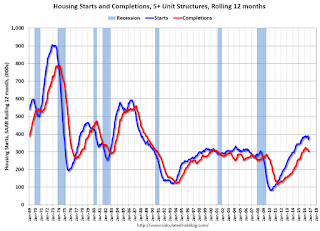by Calculated Risk on 11/17/2016 01:45:00 PM
Thursday, November 17, 2016
Comments on October Housing Starts
Earlier: Housing Starts increased to 1.323 Million Annual Rate in October
There was a sharp decline in multi-family starts in the previous month (September), and multi-family bounced back in October.
But the big story is single family starts were up again, and there were upward revisions to the prior two months combined. As always, I wouldn't put too much emphasis on any one report, but the trend is positive!
This first graph shows the month to month comparison between 2015 (blue) and 2016 (red).

Year-to-date starts are up 5.9% compared to the same period in 2015. My guess was starts would increase 4% to 8% in 2016, and that still looks about right.
Multi-family starts are down 1.8% year-to-date, and single-family starts are up 10.1% year-to-date.
Below is an update to the graph comparing multi-family starts and completions. Since it usually takes over a year on average to complete a multi-family project, there is a lag between multi-family starts and completions. Completions are important because that is new supply added to the market, and starts are important because that is future new supply (units under construction is also important for employment).
These graphs use a 12 month rolling total for NSA starts and completions.

The rolling 12 month total for starts (blue line) increased steadily over the last few years, and completions (red line) have lagged behind - but completions have been catching up (more deliveries, although this has dipped lately). Completions lag starts by about 12 months.
I think most of the growth in multi-family starts is probably behind us - in fact multi-family starts probably peaked in June 2015 (at 510 thousand SAAR) - although I expect solid multi-family starts for a few more years (based on demographics). I also expect completions to move up some more (closer to starts).

Note the exceptionally low level of single family starts and completions. The "wide bottom" was what I was forecasting several years ago, and now I expect several years of increasing single family starts and completions.
A strong housing report.


